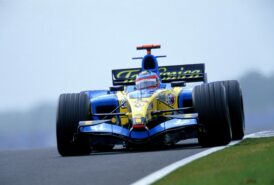Renault R25 specs & info

2005 British Grand Prix
Silverstone, England. 8th - 10th July 2005
Fernando Alonso, Renault R25, action.
Renault's F1 car for 2006
Technical specifications Renault R25 F1 car
Chassis: Moulded carbon fibre and aluminium honeycomb composite monocoque, manufactured by the Renault F1 Team and designed for maximum strength and stiffness with minimum weight. Engine installed as a fully-stressed member.
Front suspension: Carbon fibre top and bottom wishbones operate an inboard titanium rocker via a pushrod system. This is connected to a torsion bar and damper units which are mounted at the front of the monocoque.
Rear suspension: Carbon fibre top and bottom wishbones operating vertically-mounted torsion bars and horizontally-mounted damper units mounted on the top of the gearbox casing. Bottom wishbone attached by 'v' keel mounting.
Transmission: Six-speed semi-automatic gearbox with one reverse gear.
Fuel system: Kevlar-reinforced rubber fuel cell provides reduced risk of fire and is mounted behind cockpit in chassis monocoque.
Cooling system: Separate oil and water radiators located in the car's sidepods and cooled using airflow from the car's forward motion.
Electrical: Integrated chassis/engine electronics and software co- developed by Renault F1 Team and Magneti Marelli.
Braking system: Carbon discs and pads (Hitco); calipers by AP Racing.
Cockpit: Removable driver's seat made of anatomically formed carbon composite, with six-point harness seat belt. Steering wheel integrates gear change and clutch paddles.
Car dimensions and weight:
- Front track: 1,450mm Rear track: 1,400mm Wheel base: 3,100mm
- Overall length: 4,800mm Overall height: 950mm Overall width: 1,800mm
- Overall weight: 605kg including driver, camera and ballast
RS25 engine: 72° 'V' angle with optimum integration in the new R25 chassis. Atmospheric 3-litre V10 engine
The car is known for its elaborative implementation of the 'shark gills' which were previously used by Ferrari on a smaller scale. Although being usually slower than the McLaren MP4-20 in the second half of the season, Renault took the advantage in the first half of the season where they won the first 6 grand prix.











LAST 3 F1 Fan COMMENTS